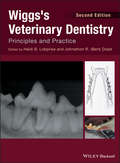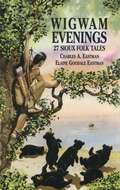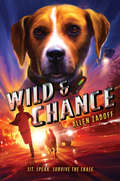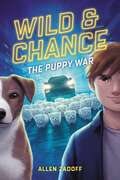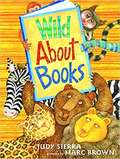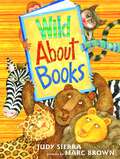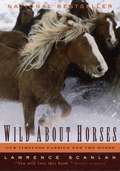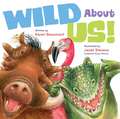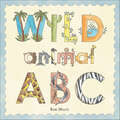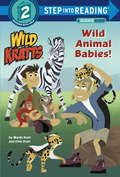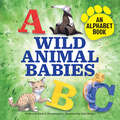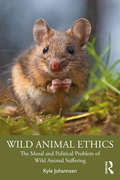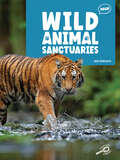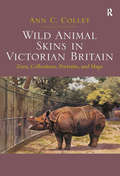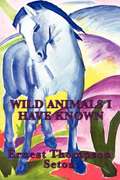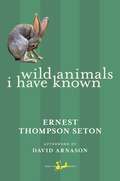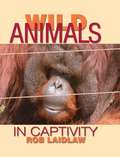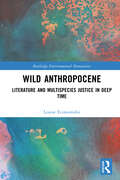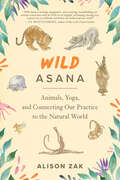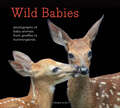- Table View
- List View
Wiggs's Veterinary Dentistry: Principles and Practice
by Heidi B. Lobprise J. R. DoddWiggs’s Veterinary Dentistry: Principles and Practice, Second Edition is a fully updated and expanded new edition of the classic comprehensive reference for veterinary dentistry. Provides current, comprehensive information on veterinary dentistry Encompasses rudimentary tenets of the field as well as advanced techniques Presents the state-of-the-art in veterinary dentistry, with all topics fully updated, revised, and expanded to reflect current knowledge Written by leading veterinary dental specialists and edited by luminaries in the field Includes more images and color throughout to support the text
Wigwam Evenings: 27 Sioux Folk Tales (The Land of Oz)
by Elaine Goodale Eastman Charles A EastmanEach of the 27 captivating tales in this rich collection, passed down from generation to generation, long ago provided an evening's entertainment and instruction for Sioux youngsters sitting spellbound around the campfire. Shortened and simplified for young readers and listeners of today, the stories include creation myths, animal fables reminiscent of Aesop, and stories of brave heroes, beautiful princesses, wicked witches, cruel giants, and other universal characters. In these stories, however, the characters unmistakably belong to the fascinating world of the Plains Indians.Among the memorable tales in this collection are "The Buffalo and the Field-Mouse," "The Raccoon and the Bee-Tree," "Unktomee and His Bundle of Songs," "The Festival of the Little People," "The Little Boy Man," "The First Battle," "The Beloved of the Sun," "The Laugh-Maker," "The Girl Who Married the Star," "North Wind and Star Boy," "The Magic Arrows," "The Ghost-Wife," and 15 more. Chosen by Charles A. Eastman, who was raised as a Sioux in the 1870s and 1880s, the tales include such unforgettable characters as Unktomee, the sly one (much like Br'er Fox of the Uncle Remus stories); Chanotedah (an Indian brownie or gnome); and the cannibal giants Eya and Double-Face. Young readers and students of Native American legend and lore will delight in these authentic, time-honored stories.
Wild & Chance (Wild & Chance Ser. #1)
by Allen ZadoffJason Bourne meets Homeward Bound in this fast-paced tale about an unusually intelligent dog with amnesia who must discover -- and then face -- her past with the help of a new friend.When a girl wakes up trapped on a sinking ship with no memory of who she is, she has nothing but her instinct to survive. As she fights her way to freedom, she quickly discovers two incredible facts: She is a dog and she can understand human speech.Soon, she befriends a thirteen-year-old boy named Chance who gives her a name of her own -- Wild. But Wild and Chance find themselves running for their lives, pursued by relentless Animal Control officers.Joined by a mysterious hacker girl named Junebug, the unlikely trio fight for survival while trying to solve the mystery of Wild's extraordinary strength, super-intelligence, and high-tech collar.Equal parts heart-pounding action and heartfelt journey, Wild & Chance grabs the reader from page one and never lets go.
Wild & Chance: The Puppy War (Wild & Chance #2)
by Allen ZadoffJason Bourne meets Homeward Bound in book two of this fast-paced series where Wild—an unusually intelligent dog—must stop adorably cute, but dangerous, puppies from being released to the greater Los Angeles area with the help of her friends.Wild has been on the run—jumping from one family to the next—ever since she left Chance almost a year ago. But when a mysterious canine corporation, C.A.T., abducts her and threatens to hurt Chance, she will stop at nothing to escape and find her old friend.Together again, Wild and Chance must enlist the help of Junebug to hack into C.A.T.'s computer to discover what they really want. But along the way, the group is reunited with an old friend and introduced to the Puppio puppies—love-at-first-sight cute, with massive eyes, who smell like apple pie. Even though they may look cute on the outside, Wild is convinced everything isn't as it seems.When she finds out a shocking discovery about her past, Wild must decide who is more important to protect—her past, her best friend, or the greater Los Angeles area who are in incredible Puppio danger.Equal parts heart-pounding action and heartfelt journey, this second book in the Wild & Chance series grabs readers from page one and never lets go.
Wild About Bears
by Jeannie BrettA comprehensive look at the world&’s eight bear species.Discover shared traits and behaviors as well as unique characteristics of the polar bear, brown bear, North American black bear, spectacled bear, Asiatic black bear, sloth bear, sun bear, and giant panda. Readers will marvel at the adaptations each has developed to survive in a challenging world.Jeannie Brett&’s stunning artwork, coupled with her thorough research, brings each bear and its habitat to life. Appended with a glossary and an illustrated world map that shows the location of bear habitats.
Wild About Books
by Judy Sierra<p>It started the summer of 2002, when the Springfield librarian, Molly McGrew, by mistake drove her bookmobile into the zoo. <p>In this rollicking rhymed story, Molly introduces birds and beasts to this new something called reading. She finds the perfect book for every animal—tall books for giraffes, tiny ones for crickets. “She even found waterproof books for the otter, who never went swimming without Harry Potter.” In no time at all, Molly has them “forsaking their niches, their nests, and their nooks,” going “wild, simply wild, about wonderful books.” Judy Sierra’s funny animal tale coupled with Marc Brown’s lush, fanciful paintings will have the same effect on young Homo sapiens. Altogether, it’s more fun than a barrel of monkeys!</p>
Wild About Books
by Judy SierraOVER HALF A MILLION COPIES SOLD!Winner of the E.B. White Read Aloud AwardIt started the summer of 2002, when the Springfield librarian, Molly McGrew, by mistake drove her bookmobile into the zoo. In this rollicking rhymed story, Molly introduces birds and beasts to this new something called reading. She finds the perfect book for every animal—tall books for giraffes, tiny ones for crickets. &“She even found waterproof books for the otter, who never went swimming without Harry Potter.&” In no time at all, Molly has them &“forsaking their niches, their nests, and their nooks,&” going &“wild, simply wild, about wonderful books.&” Judy Sierra&’s funny animal tale coupled with Marc Brown&’s lush, fanciful paintings will have the same effect on young Homo sapiens. Altogether, it&’s more fun than a barrel of monkeys!
Wild About Books
by Judy SierraA librarian named Molly McGrew introduces the animals in the zoo to the joy of reading when she drives her bookmobile to the zoo by mistake.
Wild About Dads
by Diana MurraySee lions snuggle on the savanna and groundhogs play on the prairie in Diana Murray's Wild About Dads, a heartwarming picture book that celebrates dads of all kinds—featuring illustrations by Amber Alvarez!Dads can help you reach up high,and help to keep you warm and dry.Dads are strong, dads are brave,but sometimes dads could use a shave.Everyone loves dads—humans, lions, frogs, prairie dogs, and even pelicans! See all these animals snuggle their little ones in this sweet, rhyming picture book that celebrates fatherhood in its many forms. Perfect for Father’s Day and showing dads how much they mean to you every day of the year. An Imprint Book
Wild About Horses: Our Timeless Passion for the Horse
by Lawrence ScanlanWhy do humans love horses, and why has this ancient love affair endured for so long? Horses, more than any other animal, have shaped the course of human history. The horse closed the gap between distant lands, changed the nature of the hunt, and altered the conduct of war. The bond that formed between humans and horses extends back more than six thousand years and continues today, stronger than ever. In this age of technology, it is a curious truth that many of us cannot get enough of horses: we watch them, ride them, read about them. Is this nostalgia for a simpler time, a time when at least you could count on your horse? Or is it something else, something much deeper? "Wild About Horses considers the question from many angles. Moving effortlessly from history to literature, from science to sport, from anecdote to personal experience, Lawrence Scanlan sets out to discover the essence of our powerful, almost mystical attraction to this noble creature. Scanlan covers a wide territory: from the mythic horses of cultures long past to the real-life whisperers of today, to the timeless wild mustangs still roaming the great plains. He tells stirring tales of famous horses, and of horses who should be famous. He chronicles some extraordinary journeys on horseback, and he examines the roles that horses have played both in battle and in Hollywood. As he touches on each aspect of the equine-human bond, Scanlan makes perfect sense of "horse fever"--that c
Wild About Us!
by Janet Stevens Karen BeaumontWarty Warthog may have warts and tusks, but he likes himself that way! Join him as he celebrates all of his animal friends and the attributes that make each one unique. Whether it’s Crocodile's toothy grin or Kangaroo’s huge feet or Leopard’s spottiness, each animal is different. Wouldn’t it be dull if all the animals at the zoo—and all the people in the world—looked alike? A joyful picture-book celebration of everything that makes us individuals!
Wild Animal ABC
by P. J. HultsFrom Allen the Aardvark to Zack the Zebra, kids are introduced to the alphabet in this whimsically illustrated picture book featuring charming wild animals! With each turn of the page, discover a positive message from A to Z that encourages kindness to old friends and new, while celebrating reading, learning, and creating. The book is filled with original watercolors and simple rhymes, and 26 wild animals with distinct personalities and valuable character traits remind us that simple fun is best, silly is good, and it's important to always be yourself. Join Chester the Chipmunk, Ingrid the Ibis, Wilhelmina the Whale, and all their friends as they bring the ABCs to life. Nonfiction facts and a full spread of all the animals wearing hats add an extra touch of educational fun.
Wild Animal Babies! (Step into Reading)
by Random House Chris Kratt Martin KrattA Step 2 Step into Reading Science Reader about baby animals. PBS's hit animated show Wild Kratts follows the adventures of zoologists Chris and Martin Kratt as the duo visits animal habitats around the globe. Along the way, they encounter incredible creatures while combining science education with fun. Boys and girls ages 4 to 6 will dive into this deluxe Step 2 Step into Reading leveled reader with the Kratt brothers as they activate their Creature Power suits to creep, crawl, and cuddle with amazing animal babies of all kinds! Step 2 Readers use basic vocabulary and short sentences to tell simple stories. For children who recognize familiar words and can sound out new words with help.
Wild Animal Babies: An Alphabet Book
by Katie T. ChristiansenLearn the alphabet with wild baby animals!—an alphabet book for ages 3 to 5 From sticky-tongued Anteater pups to striped Zebra foals, introduce your 3- to 5-year-old to the alphabet the fun way with some of the most adorable wild animal babies from around the world. Did you know baby Jackrabbits use their jumbo-sized ears to cool off in the hot desert? Or that Rhinoceros calves roll in the mud to protect their skin? Kids will have a blast discovering cool facts on the homes, habits, and family relationships of these lovable wild animals while getting up close and personal with cute and colorful illustrations. This animal-themed alphabet book includes: A is for animal—Your little one will learn the alphabet with one animal for each letter from A-Z plus the name for each baby animal. Adorable artwork—Engaging illustrations invite your child on a memorable journey into the wild world of 26 baby animals. Wildlife facts—From the scrublands of Australia to the rain forests of South America to the savannas of Africa, tiny explorers get to see how each baby animal lives, loves, and grows. Bring the alphabet to life in the wild with the cute and colorful creatures in Wild Animal Babies.
Wild Animal Ethics: The Moral and Political Problem of Wild Animal Suffering
by Kyle JohannsenThough many ethicists have the intuition that we should leave nature alone, Kyle Johannsen argues that we have a duty to research safe ways of providing large-scale assistance to wild animals. Using concepts from moral and political philosophy to analyze the issue of wild animal suffering (WAS), Johannsen explores how a collective, institutional obligation to assist wild animals should be understood. He claims that with enough research, genetic editing may one day give us the power to safely intervene without perpetually interfering with wild animals’ liberties. Questions addressed include: In what way is nature valuable and is intervention compatible with that value? Is intervention a requirement of justice? What are the implications of WAS for animal rights advocacy? What types of intervention are promising? Expertly moving the debate about human relations with wild animals beyond its traditional confines, Wild Animal Ethics is essential reading for students and scholars of political philosophy and political theory studying animal ethics, environmental ethics, and environmental philosophy.
Wild Animal Sanctuaries (Animal Sanctuaries)
by BreachHuman activity often puts the health and homes of wild animals in danger, but we can also help save wild animals and their habitats by protecting them with sanctuaries. Come learn about wild animal sanctuaries and what life is like for animals who call it home in this animal book about Wild Animal Sanctuaries!Part of the Animal Sanctuaries Children’s Book Series, this 24-page nonfiction book explores life for animals in wild animal sanctuaries, and how and why it is safe and healing for them.Animal Book Features:Comprehension questionsExtension activitySupports NGSS StandardsAbout Rourke Educational Media:We proudly publish respectful and relevant nonfiction and fiction titles that represent our diverse readers, and are designed to support reading on a level that has no limits!
Wild Animal Skins in Victorian Britain: Zoos, Collections, Portraits, and Maps
by Ann C. ColleyWhat did the 13th Earl of Derby, his twenty-two-year-old niece, Manchester’s Belle Vue Zoo, and even some ordinary laborers all have in common? All were avid collectors and exhibitors of exotic, and frequently unruly, specimens. In her study of Britain’s craze for natural history collecting, Ann C. Colley makes extensive use of archival materials to examine the challenges, preoccupations, and disordered circumstances that attended the amassing of specimens from faraway places only vaguely known to the British public. As scientific institutions sent collectors to bring back exotic animals and birds for study and classification by anatomists and zoologist, it soon became apparent that collecting skins rather than live animals or birds was a relatively more manageable endeavor. Colley looks at the collecting, exhibiting, and portraying of animal skins to show their importance as trophies of empire and representations of identity. While a zoo might display skins to promote and glorify Britain’s colonial achievements, Colley suggests that the reality of collecting was characterized more by chaos than imperial order. For example, Edward Lear’s commissioned illustrations of the Earl of Derby’s extensive collection challenge the colonial’s or collector’s commanding gaze, while the Victorian public demonstrated a yearning to connect with their own wildness by touching the skins of animals. Colley concludes with a discussion of the metaphorical uses of wild skins by Gerard Manley Hopkins and other writers, exploring the idea of skin as a locus of memory and touch where one’s past can be traced in the same way that nineteenth-century mapmakers charted a landscape. Throughout the book Colley calls upon recent theories about the nature and function of skin and touch to structure her discussion of the Victorian fascination with wild animal skins.
Wild Animals I Have Known
by Ernest Thompson SetonA stirring account of the lives of eight wild animals, including Lobo, the king of Currumpaw; Silverspot, the story of a crow; Raggylug, the story of a cottontail rabbit; Bingo, the story of a dog; the Springfield fox; the pacing mustang; Wully, the story of a yaller dog; and Redruff, the story of the Don valley partridge.
Wild Animals I Have Known (New Canadian Library)
by Ernest Thompson Seton David ArnasonAn immediate success upon its first publication in 1898, Wild Animals I Have Known gave the animal story new credibility and power as a literary genre and remains Seton's best-loved work.From the Paperback edition.
Wild Animals in Captivity
by Rob LaidlawAn eye-opening look at how zoo-life affects the health and behavior of wild animals, including elephants, polar bears, whales, and apes.
Wild Animals of the Southwest
by George Corey FranklinA collection of short stories about some wild animals that can be found in the southwestern United States. Each takes a unique look at a different animal.
Wild Anthropocene: Literature and Multispecies Justice in Deep Time (Routledge Environmental Humanities)
by Louise EconomidesWild Anthropocene examines four key areas—the politics of deep time, neoliberalism's socio-ecological impacts, global population growth and inter-species entanglement—to demonstrate how literature illuminates progressive solutions to Anthropocene challenges. The book argues that technological mitigation of contemporary environmental crises must be complimented by a politics committed to multispecies justice. Central to this new politics is the project of reimagining our relationship with time as something other than its status within capitalist praxis.The book brings together poetry and fiction written by a diverse range of writers to demonstrate how contemporary literature addresses important connections between social oppression and environmental issues. It also critiques techno-managerial visions of the future that celebrate humanity's ever-growing "control" over ecosystems by examining multiple sources of wildness (temporal, environmental and technological) that expose the problematic ideology underwriting such aspirations. Readers will be introduced to a way of understanding the Anthropocene that, while being informed by recent discoveries in earth science and evolutionary biology, also makes a strong case for humanities-based understanding of environmental politics.This interdisciplinary text will be a useful addition to theoretical discussions on the Anthropocene for scholars, researchers and students in the environmental humanities, literary studies, ecocriticism and environmental philosophy.
Wild Asana: Animals, Yoga, and Connecting Our Practice to the Natural World
by Alison ZakEver wonder about the dog in Downward Dog or the pigeon in Kapota? Rewild your yoga practice by connecting to the animals behind the asanas.For nature-loving yogis and readers of World of Wonders and Yoga MythologyFrom Downward Dog to Cobra, Wild Asana invites you into an embodied exploration of the animals that inspire familiar yoga poses. Drawing on wildlife science, anthropology, Hindu mythology, Eastern philosophy, and personal stories, this insightful guide by environmental educator and yoga instructor Alison Zak explores the connections among our bodies, our minds, and the animals that inspire our practice.In illustrated chapters on asanas like Tittibhasana (Firefly), Garudasana (Eagle), Bidalasana (Cat), and Ustrasana (Camel), Zak invites you to bring the deep nature of animals into breath and movement.You&’ll learn to: Respect the monkey in &“monkey mind&” to honor—not tame—your own wildnessFly like an eagle to move from imprisonment to liberation Embody a pigeon&’s stillness and nonattachmentImbue your practice with the agility, flexibility, and fierce commitment of a cat Incorporate asana variations, mudras, and meditations inspired by animal naturePractice lovingkindness meditations that include the more-than-human world With an encompassing ecological compassion, gorgeous original illustrations, profound insight into animal wisdom, and the humor and perspective of lived experience, Zak offers a path to deepen and enliven your practice. Whether you&’re an animal lover, a first-time yoga student, or an experienced practitioner, Wild Asana is a practical and accessible guide to becoming animal on your yoga mat.
Wild Babies: Photographs of Baby Animals from Giraffes to Hummingbirds
by Traer Scott&“Baby animals in all their glory,&” an award winning photographer &“strives to educate her readers while winning their hearts with her photography&” (The Boston Globe). Bestselling author and photographer Traer Scott captures the magic and wonder of a young animal's first weeks of life in this heartwarming collection of photographs. Featuring portraits of more than thirty baby animals, Wild Babies provides a glimpse into the rarely seen world of newborn creatures. From rambunctious little kangaroos and fluffy fox cubs to a wide-eyed elephant seal pup and a tiny painted turtle, these playful images are paired with engaging text that highlights the remarkable moments in wild infants' first days as they learn to eat, walk, swim, and fly. Animal lovers will delight in these close-up shots and fun trivia celebrating the unique personalities of irresistibly cute creatures navigating their way out into the world for the very first time. &“We dare you not to smile while looking at these baby balls of fluff and feathers.&” —Readers Digest &“Is there anything sweeter than an infant opossum with soft gray fur, translucent pink nose and shining onyx eyes? If so, it&’s probably in Traer Scott&’s portrait-photographs for Wild Babies, a book that softens the heart so swiftly that it&’s hard to get through two pages without murmuring &‘aww!&’&” —The Wall Street Journal &“Animal lovers, prepare yourselves to be absolutely smitten with these close-up photos of baby animals as they navigate the wondrous first weeks of their lives. . . . [A]n encyclopedic breadth of the baby animal kingdom.&” —My Modern Met
